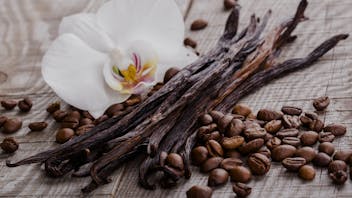Product Overview
Our very fresh organic Rosemary ct cineole has an intense, diffusive, clean, sweet-herbaceous aroma with a somewhat warm camphoraceous undertone becoming a pleasing dry, woody/balsamic aroma in the dry down. It is one of the most appealing of all the Rosemary oils we have smelled; its complex aromatic profile displays the quality of an oil that has been distilled with great care. Salvia rosmarinus essential oils are routinely adulterated or diluted with inexpensive and abundant sources of camphor and 1,8-cineole, and this is one of the reasons why we have an analysis of the oil on hand – quality can only be assured by producers who make the oils exclusively for the aromatherapy market and whose oils command an appropriate and realistic price.[1]
Rosemary is a well known herb native to the Mediterranean region, abundantly growing wild in Spain, France, Corsica, Italy, Sardinia, Russia, Turkey, the Middle East, Libya, Tunisia, Algeria, Morocco, etc.[2] The odor character and constituent profile of Rosemary oil varies according to where the plants grow (altitude and climate), what plant parts are distilled, and whether the plant material is fresh or dried when distilled.[3] Rosemary was sacred to the ancient Greeks and Romans who used it as a symbol of renewal and employed its aromatic qualities in incense.[4] Even Shakespeare alluded to the reverence for the plant when he claimed, in the words of Hamlet’s Ophelia, “There’s Rosemary, that’s for remembrance.”
The designation of chemotypes (ct) of an essential oil is necessary when distinctly different chemical compositions of the same species are produced; due to their different compositions, these oils can be applied to varying purposes. In the aromatherapy market, Rosemary essential oil will appear as one of three main chemotypes – cineole, camphor or verbenone – each of which has different applications. Oils listed simply as “Rosemary” are suspect for highly profitable adulteration. The cineole chemotype of Rosemary is the version we recommend most frequently. The aroma of Rosemary ct Cineole is suitable in enlivening massage and diffuser blends, in a diffuser while studying or at work, and in scalp and hair preparations. The verbenone chemotype is meant for more specialty applications in skincare formulations and chest rubs.
1 Schnaubelt, Kurt. Advanced Aromatherapy, 1995, p. 87.
2 Arctander, Steffen. Perfume and Flavor Materials of Natural Origin, 1960, pp. 557-8.
3 Poucher, William A. Perfumes, Cosmetics & Soaps, Vol. 1, 1930, p. 310.
4 Aromatherapy for the Family, Jan Kusmirek, ed., 1992, p. 47.



